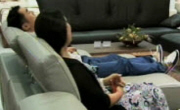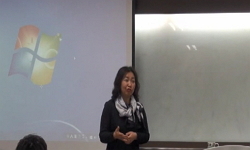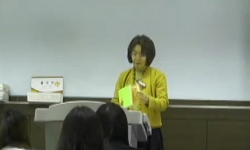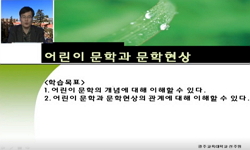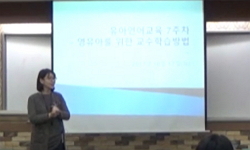이솝우화 양식을 비롯해 서구 우화에 대한 교육적 측면의 연구, 서구문학 연구분야에서의 우화 연구와 고전문학의 우언 연구는 활발하다. 그러나 아동문학에서 우화 연구는 활발하지 못하...
http://chineseinput.net/에서 pinyin(병음)방식으로 중국어를 변환할 수 있습니다.
변환된 중국어를 복사하여 사용하시면 됩니다.
- 中文 을 입력하시려면 zhongwen을 입력하시고 space를누르시면됩니다.
- 北京 을 입력하시려면 beijing을 입력하시고 space를 누르시면 됩니다.
https://www.riss.kr/link?id=T11582676
- 저자
-
발행사항
인천 : 인하대학교 일반대학원, 2009
-
학위논문사항
학위논문(석사) -- 인하대학교 일반대학원 , 국어국문학과 , 2009. 2
-
발행연도
2009
-
작성언어
한국어
- 주제어
-
DDC
372.64 판사항(21)
-
발행국(도시)
인천
-
형태사항
91 p. : 삽도 ; 26cm
-
일반주기명
인하대학교 논문은 저작권에의해 보호 받습니다.
지도교수:최원식
참고문헌 : p.85-87 - 소장기관
-
0
상세조회 -
0
다운로드
부가정보
국문 초록 (Abstract)
이솝우화 양식을 비롯해 서구 우화에 대한 교육적 측면의 연구, 서구문학 연구분야에서의 우화 연구와 고전문학의 우언 연구는 활발하다. 그러나 아동문학에서 우화 연구는 활발하지 못하다. 한국 아동문학사에「어린이」지는 지대한 영향을 끼쳤다. 1920-30년대는「어린이」지의 탄생으로 아동문학이 본격적으로 우리 문학사에서 그 위치를 확보해가는 단초가 되었고,「어린이」는 근대적인 아동관이 확립되어가면서 근대 우리 아동문학계를 대표했다. 따라서「어린이」(1923.3.20-1934.2)에 발표되었던 다수의 우화적 양식들과 양상에 대한 고찰을 시도했다.
한국 아동문학계에서는 우언보다 ‘우화’가 어린이 문학에서는 주로 사용되고 있다. 그 이유는「어린이」지와 유관하다.「어린이」필진들이 ‘우화’를 빈번하게 사용함으로써 ‘우언’이나 ‘이솝이야기’와 같은 용어를 대신했기 때문이다.「어린이」지는 ‘우화’를 소개하고 ‘우화’라는 용어를 정착시켰다. 이로써 현재에 이르기까지 ‘우화’가 우리에게 친숙한 용어가 되었다.
「어린이」지는 동화, 소설, 우화 등의 다양한 장르 등을 소개시키고, 발전시켰다. 이에「어린이」지를 통해 근대 아동 우화 문학의 서사, 묘사, 인물성격, 문학성, 역사의식, 발전과정 등에 대한 검토작업을 했다. 그러나 우화를 연구함에 있어서 양식의 기준이 정확히 마련되지 못하고 있는 문제점이 있다. 형식상 갈래인 서구개념의 ‘우화’와 내용상 갈래인 한문 전통의 개념인 ‘우언’이 착종하는 가운데 다양한 용어들이 우화임을 표방하고 있기 때문이다. 따라서「어린이」에 소개된 우화 양식구분이 좀더 명확해지기 위해 원전을 밝혀내는 작업을 시도했다.「어린이」지에는 출처를 정확하게 표기하지 않고 각색한 작품들이 많았다. 이에「어린이」에 소개된 민담, 의인동화, 우화, 우언이 우화와 긴밀하게 착종되어 있는 작품들을 발췌해서 구분하는 작업을 했다.「어린이」에 소개된 우화들은 대부분 서구 우화들을 소개한 것들이다. 양식에 있어서도 이솝우화를 비롯해 다양한 양식이 착종되었지만 이솝우화양식이 도드라지게 보인다. 또 우화의 연원은 이솝우화 뿐 아니라 끄르일로프, 라퐁텐, 판차탄트라 등 다양했다. 이러한 서구 우화문학은「어린이」를 통해 소개되면서 전반적으로 번안을 통해 문체가 화려해졌다. 이는 어린이들에게 기쁨과 재미를 주기 위한 편집방향 때문이었다. 따라서 구수한 입말체를 살린 각색이 돋보이는 작품들이 많았다. 주로 방정환의 작품들이 그러하였다. 원작을 뛰어넘은 좋은 작품들도 있다. 한국적인 특성을 살리며 해학적인 기지가 넘치며 사고의 틀을 확장시켜갈 수 있는 문체와 교훈이 돋보이는 작품들이 그것이다. 우화를 표방했지만 우화가 아닌 작품들도 있다. 교설조가 강하게 드러나는 우화와 재미와 웃음이 더 강한 문체의 우화들도 있다.
「어린이」지에 드러난 근대 우화의 경향은 방정환 아동 문학관과 맥을 같이 한다. 그는 식민지 조선의 어린이가 일본의 신민화 교육 때문에 조선 어린이의 개성과 감성을 드러낼 수 없는 것에 대해 고민했다. 같은 시기 일본은 자유교육론이 주창되면서「빨간새」를 위시로 한 감성교육에 대한 효용론이 대세를 이루고 있었기 때문이다. 따라서 그는「어린이」를 통해 조선 어린이들에게 어울리는 효과적인 교육을 하려 했다. 이는「어린이」의 편집방향과 같았다. 방정환은 ‘재미’와 ‘유열’을 주는 문학이 어린이를 위한 문학이라고 생각했다. 따라서 우화의 교훈성보다 즐거움과 읽는 맛을 더 살린 ‘우화’를 확인할 수 있다.
「어린이」誌를 통해 현재 우리가 통념적으로 알고 있는 우화의 양식과 줄거리들이 소개되었다. 양재응의 <박쥐 이야기>와 박진식의 <개갭이>,<금도끼>,<서울쥐와 시골쥐>와 같은 작품들은「어린이」지를 통해 소개되었고 이로 인해 지금까지 전형적인 우화의 소재와 줄거리로 각인되었다. 그러나「어린이」誌에서 활발히 우화를 했음에도 불구하고 이후 독립된 장르로서 번성하지 못한 점에 대한 연구가 추후 필요할 것이다.
다국어 초록 (Multilingual Abstract)
Researches from the educational viewpoint on the western allegories such as Aesop's Fables, researches on allegories in the western literature field, and researches on allegories in classical literature have been quite active. However, researches in F...
Researches from the educational viewpoint on the western allegories such as Aesop's Fables, researches on allegories in the western literature field, and researches on allegories in classical literature have been quite active. However, researches in Fables in the children's literature have not been active. Accordingly, in order to find out the concept and the styles, and contents of the Fables, and the origins of 'Fables' as we understand commonly, a magazine called 『Children』 was selected as the subject of research as the first stept. The magazine 『Children』 influenced the Korean children's literature immensely. During the 1920's to 1930's, the birth of the magazine signaled the start of the children's literature in Korea, and the magazine represented Korean children's literature field while the modern view of children was being established. Accordingly, in this research, studies were conducted on the styles and types of the fables published in the magazine between March 20 of 1923 and February of 1934.
In Korean children's literature, 'fables' were used more often than allegories. That aspect has something to do with the magazine "Children'. The writers of the magazine used the terminology 'fables' frequently and interchangeably with terminologies such as 'allegories' and 'Aesop's Fables'. The magazine introduced fables and implanted the word 'fables' into Korean vocabularies. Since then the word 'Fable' has become familiar to the general public.
The magazine introduced diverse genres such as children's stories, novels, fables, and others. For this reason reviews were made through the magazine on writing, description, characters, literature quality, historical consciousness, and developmental process. However, there is a difficulty associated with the criterion of fables in terms of the style. 'Fables', the western concept as a branch in the style and 'Allegory', and the concept of Chinese literature in the content are intermixed, and accordingly many terminologies are interchangeably used with the word 'fable'. Accordingly, in order to clarify the style of the fables introduced in the magazine, the original sources of the stories were investigated. Many stories the magazine published were adapted versions of other original stories, in which the sources were not identified in the magazine. Accordingly, literature works closely related to the folk stories, personification fairy tales, fables, and allegories published by the magazine were identified and classified so as to find out the sources. The fables introduced by the magazine are mostly based on western fables. That is, fables introduced by the magazine were of western origins. Even in the style, diverse styles such as that of Aesop's Fables were adapted, among which Aesop's fable style is most prominent.
Also, the sources of the fables were not limited to Aesop's but also included works of Krylov, Lafontaine, Panchatantra, and others. These western fable stories became more fabulous in the writing style in the process of being modified and published by the magazine 『Children』. This was caused intentionally by the magazine so as to inject more pleasure and delightfulness for the young readers. As a result many stories became notable with folky writing style in retelling the original stories. Works by Bang, Jeong-hwan were especially so. Some of the works were actually outdoing the originals. In those works the authors added Korean flavors, wits, and extended the frame of the concept by the means of writing style and extra messages. Some were not even fables even though they were presented as fables. Some were even in a sermon style, while others injected more humors and laughter.
The trend of the modern fables presented by the magazine 『Children』 is in line with that of Bang, Jeong-hwan as evidenced by his works. He agonized over a reality that the character and sensibility of the children were suppressed by the government education geared for the colonization of Korea by Japan at the time.
In that era, Japan emphasized the Liberal Education Theory, and the usefulness of sensibility education, as advocated by 『The Red Bird』, was the main trend. Accordingly it may be regarded that Bang tried to deter the Japanese colonial educational ideology by the magazine 『Children』. This coincides with the same editorial direction of the magazine. He considered 'fun' and 'exhilaration' as important elements in children's literature. Accordingly, the fables of that era were signified more by the traits of fun and pleasure than instructive elements.
Above, the styles and story lines of fables as we know today in Korea have been described through the magazine 『Children』. <A story of bat> by Yang, Jae-eung, and <Gaegaebee>by Park, Jin-sik, (The golden ax>, <A Seoul's mouse and a peasant mouse> were published through the magazine, and have become the representative subjects and story lines of fables as we know.
목차 (Table of Contents)
- Ⅰ. 서론 = 1
- 1. 연구목적 = 1
- 2. 연구방법과 연구범위 = 3
- Ⅱ. 우화의 개념 = 6
- 1. 용어의 정착 : ‘이야기’에서 ‘우화’로 = 6
- Ⅰ. 서론 = 1
- 1. 연구목적 = 1
- 2. 연구방법과 연구범위 = 3
- Ⅱ. 우화의 개념 = 6
- 1. 용어의 정착 : ‘이야기’에서 ‘우화’로 = 6
- 2. 우화, 우언, 의인동화, 민담의 양식 구분 = 9
- Ⅲ. 「어린이」誌 우화의 번안 양상 = 16
- 1. 작품 번역·번안의 대상 = 16
- 2. 우리 실정에 맞는 번역·번안 = 20
- 3. 모티브를 확대·발전시킨 번안 = 37
- Ⅳ.「어린이」誌 우화의 전개 양상 = 42
- 1. 개념의 혼란에 따른 작품들 = 42
- 2. 이솝우화 형식의 발전 = 47
- 3. 교설조의 우화 : 딱딱하고 건조한 이야기 = 48
- 4. 회화조의 우화 : 풍부한 입말체와 묘사 = 52
- Ⅴ.「어린이」誌 우화의 아동문학사적 의의 : ‘우화’ 용어의 정착 및 전형적 줄거리 양산 = 61
- Ⅵ. 결론 = 62
- 참고문헌 = 66
- ABSTRACT = 69





